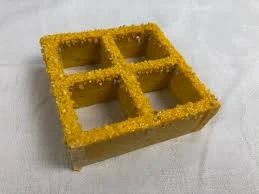loading...
- No. 9, Xingyuan South Street, Dongwaihuan Road, Zaoqiang County, Hengshui, Hebei, China
- admin@zjcomposites.com
- +86 15097380338
- Welcome to visit our website!
Understanding Sectional Water Tanks and Their Benefits for Storage Solutions
The Importance of Sectional Water Tanks in Modern Water Storage Solutions
In recent years, the demand for efficient water storage systems has surged due to rapid urbanization, population growth, and the increasing need for sustainable water management. Among various water storage solutions, sectional water tanks have gained prominence due to their versatility, adaptability, and ease of installation. This article delves into the benefits and applications of sectional water tanks, highlighting their crucial role in modern water management.
Definition and Composition
Sectional water tanks are prefabricated tanks constructed from several modular sections, typically made from materials such as fiberglass, stainless steel, or reinforced concrete. These sections are manufactured in a factory and then transported to the installation site. Once on-site, the sections are assembled using bolts or welding techniques, allowing for a customized size and capacity based on specific needs. This modular approach is particularly advantageous, as it facilitates transportation and installation in areas that may have limited access.
Advantages of Sectional Water Tanks
One of the primary benefits of sectional water tanks is their flexibility in design. Since they are built from separate sections, it is easy to increase the tank’s capacity by adding more sections as required, making them ideal for projects where future expansion is anticipated. Additionally, they can be constructed in various shapes and sizes to conform to the available space, which is especially important in urban settings where land is at a premium.
Another significant advantage is the ease of installation. Unlike traditional water tanks, which may require extensive excavation and foundation work, sectional tanks can often be installed quickly with minimal disruption. This not only saves time but also reduces labor costs, making them a cost-effective solution for both residential and commercial applications.
Applications of Sectional Water Tanks
sectional water tank

Sectional water tanks are versatile and can be utilized in a variety of settings. In urban environments, they serve as crucial components of water distribution systems, providing a reliable supply of potable water to households and businesses. In industrial settings, they are often used for process water storage, cooling systems, or even fire suppression systems, demonstrating their adaptability to different water quality and usage requirements.
They are also essential in agricultural settings, where they can store rainwater for irrigation purposes, thus promoting sustainable farming practices. By capturing and utilizing rainwater, farmers can reduce their dependency on municipal water supplies and enhance their resilience against droughts.
Furthermore, sectional water tanks are increasingly being used in disaster management efforts. They can be rapidly deployed in areas affected by natural disasters to provide emergency water supplies, ensuring that affected populations have access to clean water during crises.
Maintenance and Durability
Maintaining sectional water tanks is relatively straightforward. Regular inspections and cleaning are essential to prevent sediment build-up and ensure water quality. The materials used in their construction are often resistant to corrosion and decay, contributing to a long lifespan with minimal maintenance requirements.
Advanced engineering techniques and technology have also led to the development of sectional tanks that can withstand extreme weather conditions, making them suitable for use in various climates.
Conclusion
In conclusion, sectional water tanks represent a modern solution to the challenges of water storage and management. Their flexibility, ease of installation, and versatility make them suitable for a wide range of applications, from urban water supply systems to agricultural irrigation and emergency water storage. As the world continues to face challenges related to water availability and sustainability, sectional water tanks will undoubtedly play a pivotal role in addressing these issues, ensuring that communities have access to the water resources they need to thrive. By leveraging the advantages of these tanks, we can work towards a more sustainable and resilient future in water management.
-
The Rise of FRP Profiles: Strong, Lightweight, and Built to LastNewsJul.14,2025
-
SMC Panel Tanks: A Modern Water Storage Solution for All EnvironmentsNewsJul.14,2025
-
GRP Grating: A Modern Solution for Safe and Durable Access SystemsNewsJul.14,2025
-
Galvanized Steel Water Tanks: Durable, Reliable, and Ready for UseNewsJul.14,2025
-
FRP Mini Mesh Grating: The Safer, Smarter Flooring SolutionNewsJul.14,2025
-
Exploring FRP Vessels: Durable Solutions for Modern Fluid HandlingNewsJul.14,2025
-
GRP Structures: The Future of Lightweight, High-Performance EngineeringNewsJun.20,2025
